Where Was Donatello From Where Is the the Transfiguration Art
| The Transfiguration | |
|---|---|
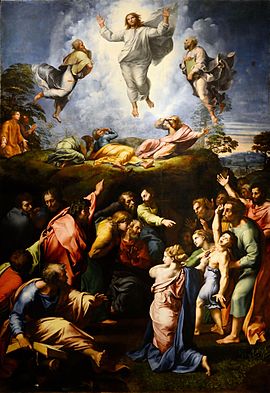 | |
| Creative person | Raphael |
| Year | 1516–twenty[ane] |
| Medium | Tempera on forest |
| Dimensions | 410 cm × 279 cm (160 in × 110 in) |
| Location | Pinacoteca Vaticana, Vatican City |
| Accession | 40333[one] |
| Website | www |
The Transfiguration is the last painting by the Italian High Renaissance master Raphael. Commissioned by Cardinal Giulio de Medici, the later Pope Clement Vii (1523–1534), and conceived as an altarpiece for the Narbonne Cathedral in France, Raphael worked on it until his death in 1520.[i] The painting exemplifies Raphael's development as an artist and the culmination of his career. Unusually for a depiction of the Transfiguration of Jesus in Christian art, the subject is combined with the next episode from the Gospels (the healing of a possessed boy) in the lower function of the painting. It is now in the Pinacoteca Vaticana in Vatican Metropolis.[one]
From the late 16th century until the early 20th century (Renaissance era), it was said to exist the most famous oil painting in the world.
History of the painting [edit]
Past December 1517, the latest date of committee, Central Giulio de Medici, cousin to Pope Leo 10 (1513–1521), was also the Pope's vice-chancellor and master advisor. He had been endowed with the legation of Bologna, the bishoprics of Albi, Ascoli, Worcester, Eger and others. From February 1515, this included the archbishopric of Narbonne.[two] He commissioned two paintings for the cathedral of Narbonne, The Transfiguration of Christ from Raphael and The Raising of Lazarus from Sebastiano del Piombo. With Michelangelo providing drawings for the latter work, Medici was rekindling the rivalry initiated a decade earlier betwixt Michelangelo and Raphael, in the Stanze and Sistine Chapel.[iii]
From xi to 12 December 1516, Michelangelo was in Rome to talk over with Pope Leo X and Cardinal Medici the facade of the Basilica of San Lorenzo in Florence. During this meeting, he was confronted with the commission of The Raising of Lazarus and it was here that he agreed to provide drawings for the endeavour, merely non to execute the painting himself. The commission went to Michelangelo's friend Sebastiano del Piombo. Every bit of this meeting the paintings would become emblematic of a paragone between two approaches to painting, and between painting and sculpture in Italian fine art.[2]
An early modello for the painting, done in Raphael's studio by Giulio Romano, depicted a 1:10 calibration drawing for The Transfiguration. Here Christ is shown on Mount Tabor. Moses and Eljah float towards him; John and James are kneeling to the correct; Peter is to the left. The top of the model depicts God the Father and a throng of angels.[2] A 2nd modello, washed by Gianfrancesco Penni, shows a design with ii scenes, as the painting was to develop. This modello is held by the Louvre.[four]
The Raising of Lazarus was unofficially on view by October 1518. By this time Raphael had barely started on his altarpiece. By the fourth dimension Sebastiano del Piombo'southward piece of work was officially inspected in the Vatican by Leo X on Sunday, eleven December 1519, the 3rd Sunday of Advent, The Transfiguration was still unfinished.[two]
Raphael would take been familiar with the concluding class of The Raising of Lazarus equally early as the autumn of 1518, and in that location is considerable evidence that he worked feverishly to compete, calculation a 2nd theme and xix figures.[two] A surviving modello for the project, now in the Louvre (a workshop copy of a lost cartoon by Raphael's assistant Gianfrancesco Penni) shows the dramatic change in the intended work.
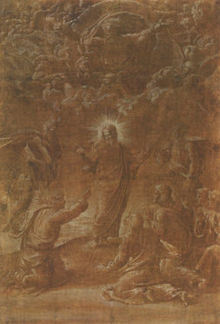
Modello for the Transfiguration of Christ, pen and brown ink with white highlights on paper primed with dark brown wash, forty 10 27 cm, c. 1516, Albertina
Examination of the concluding Transfiguration revealed more than sixteen incomplete areas and pentimenti (alterations).[ii] An of import theory holds that the writings of Blessed Amadeo Menes da Silva was key to the transformation. Amadeo was an influential friar, healer and visionary likewise as the Pope'southward confessor. He was likewise diplomat for the Vatican Country. In 1502, afterwards his death, many of Amadeo's writings and sermons were compiled as the Apocalypsis Nova. This tract was well known to Pope Leo X. Guillaume Briçonnet, Cardinal Giulio de' Medici's predecessor equally bishop of Narbonne, and his two sons too consulted the tract as spiritual guide. Cardinal Giulio knew the Apocalypsis Nova and could have influenced the painting's final composition. Amadeo'south tract describes the episodes of the Transfiguration and the possessed boy consecutively. The Transfiguration represents a prefiguration of the Final Judgment, and of the terminal defeat of the Devil. Another estimation is that the epileptic boy has been cured, thus linking the divinity of Christ with his healing ability.[5]
Raphael died on 6 April 1520. For a couple of days afterward, The Transfiguration lay at the caput of his catafalque at his house in the Borgo.[6] [7] A calendar week after his expiry, the two paintings were exhibited together in the Vatican.[two]
While there is some speculation that Raphael's pupil, Giulio Romano, and assistant, Gianfrancesco Penni, painted some of the groundwork figures in the lower right half of the painting,[iii] there is no evidence that anyone but Raphael finished the substance of the painting.[2] The cleaning of the painting from 1972 to 1976 revealed that administration only finished some of the lower left figures, while the rest of the painting is by Raphael himself.[viii]
Rather than ship it to France, Cardinal Giulio de' Medici retained the motion picture. In 1523,[4] he installed it on the high altar in the Blessed Amadeo'due south church of San Pietro in Montorio, Rome,[nine] in a frame which was the piece of work of Giovanni Barile (no longer in beingness). Giulio ordered Penni a copy of the Transfiguration to accept with him to Naples. The final result with slight differences from the original is preserved in the Prado Museum in Madrid.[10] A mosaic copy of the painting was completed by Stefano Pozzi in St. Peter's Basilica in the State of the vatican city in 1774.[iv]
In 1797, during Napoleon Bonaparte's Italian entrada, it was taken to Paris by French troops and installed in the Louvre. Already on 17 June 1794, Napoleon'due south Committee of Public Education had suggested an expert committee accompany the armies to remove important works of fine art and science for return to Paris. The Louvre, which had been opened to the public in 1793, was a clear destination for the fine art. On xix February 1799, Napoleon concluded the Treaty of Tolentino with Pope Pius 6, in which was formalized the confiscation of 100 artistic treasures from the Vatican.[11]

Wedding procession of Napoleon and Marie-Louise of Republic of austria in 1810 (detail)
Amongst the nigh sought after treasures Napoleons agents coveted were the works of Raphael. Jean-Baptiste Wicar, a member of Napoleon'south selection committee, was a collector of Raphael'due south drawings. Baron Antoine-Jean Gros, another member, had been influenced by Raphael. For artists like Jacques-Louis David, and his pupils Girodet and Ingres, Raphael represented the embodiment of French artistic ideals. Consequently, Napoleon's commission seized every available Raphael. To Napoleon, Raphael was simply the greatest of Italian artists and The Transfiguration his greatest piece of work. The painting, along with the Apollo Belvedere, the Laocoön, the Capitoline Brutus and many others, received a triumphal entry into Paris on 27 July 1798, the fourth anniversary of Maximilien de Robespierre's fall.[11]
In November 1798, The Transfiguration was on public display in the Thousand Salon at the Louvre. Every bit of 4 July 1801, it became the centrepiece of a big Raphael exhibition in the Grande Galerie. More than 20 Raphaels were on display. In 1810, a famous drawing by Benjamin Zix recorded the occasion of Napoleon and Marie Louise's wedding procession through the Grande Galerie, The Transfiguration on display in the background.[11]

St. Matthew and another apostle, red chalk over stylus, 328 ten 232 mm
The painting's presence at the Louvre gave English painters like Joseph Farington (on 1 and 6 September 1802)[12] : 1820–32 and Joseph Mallord William Turner (in September 1802) the opportunity to study it. Turner would dedicate the start of his lectures as Professor of Perspective at the Majestic Academy to the flick.[13] Farington also reported on others having been to meet the picture: Swiss painter Henry Fuseli, for whom it was second at the Louvre only to Titian's The Expiry of St. Peter Martyr (1530), and English painter John Hoppner.[12] : 1847 The Anglo-American painter Benjamin W "said that the opinion of ages stood confirmed that information technology still held the kickoff place".[12] : 1852 Farington himself expressed his sentiments equally follows:
Were I to decide by the upshot it had upon me I should not hesitate to say that the patient care and solid manner in which The Transfiguration is painted made an impression on my mind that caused other pictures esteemed of the offset Class, to appear weak, and as wanting in strength & vigour.
—Joseph Farington, The Diary of Joseph Farington Vol. V[12] : 1831
After the fall of Napoleon Bonaparte, in 1815, envoys to Pope Pius Seven, Antonio Canova and Marino Marini managed to secure The Transfiguration (along with 66 other pictures) as part of the Treaty of Paris. By agreement with the Congress of Vienna, the works were to be exhibited to the public. The original gallery was in the Borgia Apartment in the Apostolic Palace. Subsequently several moves inside the Vatican, the painting now resides in the Pinacoteca Vaticana.[14]
Reception [edit]
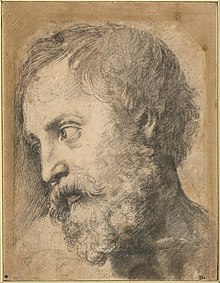
Study of the Head of an Apostle, black chalk over pouncing, c. 1519
The reception of the painting is well documented. Between the year 1525 and 1935, at least 229 written sources tin can be identified that describe, analyse, praise or criticise The Transfiguration.[15]
The get-go descriptions of the painting after Raphael's expiry in 1520 called The Transfiguration already a masterpiece, simply this status evolved until the end of the 16th century. In his notes of a travel to Rome in 1577, the Spanish humanist Pablo de Céspedes called it the most famous oil-painting in the world for the starting time fourth dimension.[sixteen] The painting would preserve this authority for more than 300 years. It was best-selling and repeated by many authors, like the connoisseur François Raguenet, who analysed Raphael's composition in 1701. In his stance, its outline drawing, the upshot of calorie-free, the colours and the arrangement of the figures fabricated The Transfiguration the near perfect painting in the world.[17]

An auxiliary cartoon for the apostle far left
Jonathan Richardson Senior and Junior dared to criticise the overwhelming status of The Transfiguration, asking if this painting could really be the most famous painting in the world.[18] They criticised that the limerick was divided into an upper and a lower half that would not correspond to each other. Too the lower one-half would draw too much attention instead of the upper one-half, while the full attending of the viewer should be paid to the figure of Christ alone. This criticism did not diminish the fame of the painting, but provoked counter-criticism by other connoisseurs and scholars. For the High german-speaking earth, information technology was the assessment by Johann Wolfgang von Goethe that prevailed. He interpreted the upper and the lower half as complementary parts. This assessment was quoted by many authors and scholars during the 19th century and thus the dominance of Goethe helped to save the fame of The Transfiguration.[19]
During the short period of time the painting spent in Paris, information technology became a major attraction to visitors, and this continued later its return to Rome, then placed in the Vatican museums. Mark Twain was ane of many visitors and he wrote in 1869: "I shall remember The Transfiguration partly considering information technology was placed in a room most by itself; partly because it is acknowledged past all to exist the first oil painting in the earth; and partly because it was wonderfully beautiful."[xx]
In the early 20th century, the fame of the painting chop-chop diminished and soon The Transfiguration lost its denomination as the most famous painting in the earth. A new generation of artists did non accept Raphael as an artistic authority anymore. Copies and reproductions were no longer in high demand. While the complexity of the composition had been an argument to praise the painting until the end of the 19th century, viewers were now repelled by it. The painting was felt to be too crowded, the figures to be as well dramatic and the whole setting to be too artificial. In contrast, other paintings like the Mona Lisa by Leonardo da Vinci were much easier to recognise and did not suffer from the decline of the overwhelming status of Raphael every bit an artistic example.[21] Thus The Transfiguration is a skillful example for the changeability of the fame of an artwork, that may terminal for centuries but may also refuse in merely a short period.
Reproductions [edit]
The fame of the painting is too based on its reproduction. While the original could only be admired in 1 place – in Rome, and for a short period of fourth dimension in Paris later on it had been taken away by Napoleon – the large number of reproductions ensured that the composition of the painting was omnipresent in nearly every important art collection in Europe. It could thus exist studied and admired past many collectors, connoisseurs, artists and art historians.
Including the mosaic in St Peter'southward in the Vatican, at to the lowest degree 68 copies were made betwixt 1523 and 1913.[15] Good copies afterwards the painting were highly sought afterwards during the Early on Modern menstruum and immature artists could earn money for an Italian journeying by selling copies of The Transfiguration. One of the all-time painted copies ever was made by Gregor Urquhart in 1827.[22] At least 52 engravings and etchings were produced afterwards the painting until the end of the 19th century, including illustrations for books like biographies and even for Christian songbooks.[15] The Istituto nazionale per la grafica in Rome possesses twelve of these reproductions.[23] At to the lowest degree 32 etchings and engravings tin can be traced that depict details of the painting, sometimes to employ them as a function of a new composition.[fifteen] Among these depictions of details is i set of prints of heads, easily and feet engraved by Chiliad. Folo afterward Vincenzo Camuccini (1806), and another set of heads produced in stipple engraving past J. Godby afterwards drawings by I. Goubaud (1818 and 1830). The first engraved reproduction of The Transfiguration is also called to exist the first reproductive print of a painting ever. Information technology was made by an anonymous engraver in 1538 and is sometimes identified with the way of Agostino Veneziano.
Iconography [edit]
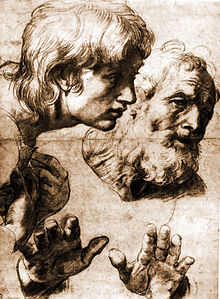
Raphael'due south painting depicts two consecutive, merely distinct, biblical narratives from the Gospel of Matthew, besides related in the Gospel of Mark. In the first, the Transfiguration of Christ itself, Moses and Elijah appear before the transfigured Christ with Peter, James and John looking on (Matthew 17:1–9; Mark 9:ii–13). In the 2nd, the Apostles neglect to cure a boy from demons and await the render of Christ (Matthew 17:fourteen–21; Mark 9:14).[3]
The upper register of the painting shows the Transfiguration itself (on Mount Tabor, according to tradition), with the transfigured Christ floating in front of illuminated clouds, between the prophets Moses, on the right, and Elijah, on the left,[24] with whom he is conversing (Matthew 17:3). The two figures kneeling on the left are commonly identified as Justus and Pastor who shared August half dozen as a feast twenty-four hours with the Feast of the Transfiguration.[25] These saints were the patrons of Medici's archbishopric and the cathedral for which the painting was intended.[two] It has also been proposed that the figures might correspond the martyrs Saint Felicissimus and Saint Agapitus who are commemorated in the missal on the feast of the Transfiguration.[four] [25]
The upper register of the painting includes, from left to right, James, Peter and John,[26] traditionally read as symbols of faith, hope and love; hence the symbolic colours of bluish-yellowish, dark-green and red for their robes.[two]
In the lower register, Raphael depicts the Apostles attempting to complimentary the possessed male child of his demonic possession. They are unable to cure the sick child until the arrival of the recently transfigured Christ, who performs a phenomenon. The youth is no longer prostrate from his seizure but is standing on his feet, and his mouth is open, which signals the departure of the demonic spirit. Every bit his last work before this decease, Raphael (which in Hebrew רָפָאֵל [Rafa'el] ways "God has healed"), joins the two scenes together as his last attestation to the healing power of the transfigured Christ. Co-ordinate to Goethe: "The two are one: below suffering, demand, above, effective power, succour. Each begetting on the other, both interacting with ane another."[27]
The human lower left is the apostle-evangelist Matthew, some would says St. Andrew,[4] depicted at middle-level and serving equally interlocutor with the viewer.[2] The function of figures similar the lesser left was best described by Leon Battista Alberti most a century earlier in 1435.
I like there to be someone in the "historia", who tells the spectators what is going on, and either beckons them with his hand to look, or with ferocious expression and forbidding glance challenges them not to come up near, equally if he wished their business to exist hugger-mugger, or points to some danger or remarkable affair in the motion-picture show, or by his gestures invites yous to laugh or weep with them.
—Leon Battista Alberti, On Painting (1435)[28]

Study of the Head of an Apostle, blackness chalk over pouncing, c. 1519
Matthew (or Andrew) gestures to the viewer to wait, his gaze focused on a kneeling woman in the lower foreground. She is ostensibly a part of the family unit grouping,[24] but on closer examination is set up apart from either group. She is a mirror paradigm of a comparable effigy in Raphael's The Expulsion of Heliodorus from the Temple (1512).[3] Giorgio Vasari, Raphael's biographer, describes the woman as "the principal figure in that panel". She kneels in a contrapposto pose, forming a compositional span between the family group on the right and the nine apostles on the left. Raphael too renders her in cooler tones and drapes her in sunlit pinkish, while he renders the other participants, apart from Matthew, oblivious to her presence.[8] The adult female's contrapposto pose is more specifically called a figura serpentinata or serpent's pose, in which the shoulders and the hips move in opposition; one of the primeval examples beingness Leonardo da Vinci'southward Leda (c. 1504), which Raphael had copied while in Florence.[8]
In the heart are four apostles of dissimilar ages. The blonde youth appears to repeat the apostle Philip from The Terminal Supper. The seated older man is Andrew. Simon is the older man backside Andrew. Judas Thaddeus is looking at Simon and pointing towards the boy.[2]
The apostle on the far left is widely considered to exist Judas Iscariot[24] He was the field of study of one of only six surviving so-chosen auxiliary cartoons, starting time described past Oskar Fischel in 1937.[29]
Assay and estimation [edit]
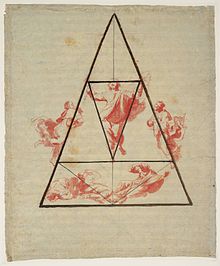
The iconography of the picture has been interpreted as a reference to the delivery of the city of Narbonne from the repeated assaults of the Saracens. Pope Calixtus III proclaimed Baronial half dozen a feast day on the occasion of the victory of the Christians in 1456.[4]
Enlightenment philosopher Montesquieu noted that the healing of the obsessed boy in the foreground takes precedence over the figure of Christ. Modern critics accept furthered Montesquieu'due south criticism by suggesting that the painting should be renamed to "Healing of the Obsessed Youth".[30]
J. Yard. W. Turner had seen The Transfiguration in the Louvre, in 1802. At the conclusion of the version of his get-go lecture, delivered on vii January 1811, as Professor of Perspective at the Royal University, Turner demonstrated how the upper part of the composition is made upward of intersecting triangles, forming a pyramid with Christ at the meridian.[31]
In a 1870 publication, German art historian Machine Justi observes that the painting depicts two subsequent episodes in the biblical narrative of Christ: after the transfiguration, Jesus encounters a homo who begs mercy for his devil-possessed son.[32]
Raphael plays on a tradition equating epilepsy with the aquatic moon (luna, from whence lunatic). This causal link is played on by the watery reflection of the moon in the lower left corner of the painting; the boy is literally moonstruck.[2] In Raphael's fourth dimension, epilepsy was oftentimes equated with the moon (morbus lunaticus), possession by demons (morbus daemonicus), and also, paradoxically, the sacred (morbus sacer). In the 16th century, information technology was non uncommon for sufferers of epilepsy to be burned at the stake, such was the fear evoked past the condition.[33] The link between the stage of the moon and epilepsy would only be broken scientifically in 1854 by Jacques-Joseph Moreau de Tours.[34]
Raphael's Transfiguration tin be considered a prefiguration of both Mannerism, every bit evidenced by the stylised, contorted poses of the figures at the bottom of the picture show; and of Bizarre painting, as evidenced by the dramatic tension imbued within those figures, and the stiff use of chiaroscuro throughout.
Equally a reflection on the creative person, Raphael probable viewed The Transfiguration as his triumph.[35] Raphael uses the contrast of Jesus presiding over men to satiate his papal commissioners in the Roman Catholic Church. Raphael uses the cave to symbolize the Renaissance style, easily observed in the extended index finger as a reference to Michelangelo's Sistine Chapel. Additionally, he subtly incorporates a landscape in the background, only uses darker coloring to show his disdain for the fashion. Yet the focal point for the viewer is the Baroque styled kid and his guarding father. In all, Raphael successfully appeased his commissioners, paid homage to his predecessors, and ushered in the subsequent predominance of Baroque painting.[ citation needed ]
On the simplest level, the painting can be interpreted every bit depicting a dichotomy: the redemptive power of Christ, every bit symbolised by the purity and symmetry of the pinnacle half of the painting; contrasted with the flaws of Human being, every bit symbolised by the dark, cluttered scenes in the bottom half of the painting.
The philosopher Nietzsche interpreted the painting in his book The Birth of Tragedy as an paradigm of the interdependence of Apollonian and Dionysian principles.[36]
The sixteenth-century painter and biographer Giorgio Vasari wrote in his Lives of the Most Excellent Painters, Sculptors, and Architects that The Transfiguration was Raphael'due south "almost beautiful and most divine" piece of work.
In popular civilisation [edit]
Fragments of the Transfiguration appear on the encompass of the Renaissance: Desire anthology mixed by Dave Seaman in 2001 and published by Ultra Records.
References [edit]
- ^ a b c d "Raffaello Sanzio, The Transfiguration". Vatican Museums. Retrieved 2021-02-13 .
- ^ a b c d e f g h i j thou l m Preimesberger, Rudolf (2011). Paragons and Paragone: Van Eyck, Raphael, Michelangelo, Caravaggio, Bernini. Getty Publications. ISBN9780892369645.
- ^ a b c d John T. Paoletti; Gary M. Radke (2005). Art in Renaissance Italy (3 ed.). Laurence King Publishing. p. 422. ISBN9781856694391 . Retrieved 2 Jan 2013.
- ^ a b c d e f Dussler, Luitpold (1971). Raphael: A Critical Catalogue of his Pictures, Wall-Paintings & Tapestries. London: Phaidon. pp. 52–55.
- ^ Honan, William H. (December xvi, 1995). "Cardiologist Answers a Raphael Question". The New York Times. p. Arts. Retrieved 25 February 2018.
- ^ "Archived re-create". Archived from the original on 2010-11-26. Retrieved 2012-06-17 .
{{cite spider web}}: CS1 maint: archived re-create as title (link) - ^ Salmi, Mario; Becherucci, Luisa; Marabottini, Alessandro; Tempesti, Anna Forlani; Marchini, Giuseppe; Becatti, Giovanni; Castagnoli, Ferdinando; Golzio, Vincenzo (1969). The Complete Work of Raphael. New York: Reynal and Co., William Morrow and Company. p. 253.
- ^ a b c Cranston, Jodi (2003). "Tropes of Revelation in Raphael's Transfiguration". Renaissance Quarterly. The University of Chicago Press. 56 (1): ane–25. doi:10.2307/1262256. JSTOR 1262256.
- ^ Joannides, Paul; Tom Henry (2012). Late Raphael. Madrid, Museo Nacional del Prado, and Paris, Musée du Louvre.
- ^ "The Transfiguration of Our Lord - The Collection - Museo Nacional del Prado". world wide web.museodelprado.es . Retrieved 22 March 2021.
{{cite web}}: CS1 maint: url-status (link) - ^ a b c Rosenberg, Martin (1985–1986). "Raphael's Transfiguration and Napoleon's Cultural Politics". Eighteenth-Century Studies. The Johns Hopkins University Press. 19 (2): 180–205. doi:10.2307/2738641. JSTOR 2738641.
- ^ a b c d Farington, Joseph (1979). Kenneth Garlick and Angus Macintyre (ed.). The Diary of Joseph Farington Vol. V. New Haven and London: Yale University Printing. ISBN9780300022957. OL 10317705M.
- ^ Dark-brown, David Blayney (October 2009). "Colour Primal of Raphael'southward 'Transfiguration' (Inscriptions by Turner) 1802 by Joseph Mallord William Turner". J.M.W. Turner: Sketchbooks, Drawings and Watercolours . Retrieved iv January 2013.
- ^ Ricci, Corrado; Ernesto Begni (2003). Vatican: Its History Its Treasures 1914. Kessinger Publishing. pp. 189–190. ISBN9780766139411 . Retrieved 4 Jan 2013.
- ^ a b c d Dohe, Sebastian (2014). Leitbild Raffael – Raffaels Leitbilder. Das Kunstwerk als visuelle Autorität. Petersberg: Michael Imhof Verlag. pp. 288–315. ISBN978-3-86568-860-6.
- ^ Dohe, Leitbild Raffael, p. 49.
- ^ Raguenet, François (1701). Les monumens de Rome ou Descriptions des plus beaux ouvrages de peinture, de sculpture et d'Architecture. Amsterdam. pp. 161–172.
- ^ Richardson, Jonathan (1728). Traité de la Peinture et de la Sculpture. Vol. iii. Amsterdam. p. 612.
Celui-cis est assurément le principal Tableau elementary qu'il y ait à-present au Monde, & qui peut-être ait jamais été?
- ^ Dohe, Leitbild Raffael, p. 65.
- ^ Twain, Marker (1869). The innocents abroad or The new pilgrims' progress. Hartford. p. 303.
- ^ Dohe, Leitbild Raffael, pp. 220-224.
- ^ Dohe, Leitbild Raffael, pp. 128-129.
- ^ (Italy), Istituto nazionale per la grafica (1985). Raphael invenit : stampe da Raffaello nelle collezioni dell'Istituto nazionale per la grafica : catalogo. Raphael, 1483-1520., Bernini Pezzini, Grazia. Roma: Edizioni Quasar. pp. 177–181, 680–684. ISBN8885020674. OCLC 13005092.
- ^ a b c "Notes on Raphael's "Transfiguration"". The Periodical of Speculative Philosophy. Pennsylvania State University Press: 53–57. 1867. Retrieved iii January 2013.
- ^ a b Kleinbub, Christian (2011). Vision and the Visionary in Raphael. Penn State Press. ISBN9780271037042.
- ^ Arbiter, Petronius (Oct 1916). "A Swell Piece of work of Art: Raphael's "Transfiguration": The Greatest Picture in the World". The Art World. one (1): 56–57, 59–sixty. doi:10.2307/25587657. JSTOR 25587657.
- ^ In Italienische Reise, December 1787, quoted Schiller, I, 152
- ^ Alberti, Leon (2005). On Painting. Penguin Books Limited. ISBN9780140433319.
- ^ Fischel, Oskar (October 1937). "Raphael'southward Auxiliary Cartoons". The Burlington Magazine (LXXI): 167–168.
- ^ Salmi, Mario; Becherucci, Luisa; Marabottini, Alessandro; Tempesti, Anna Forlani; Marchini, Giuseppe; Becatti, Giovanni; Castagnoli, Ferdinando; Golzio, Vincenzo (1969). The Consummate Work of Raphael. New York: Reynal and Co., William Morrow and Company. p. 626.
- ^ Fredericksen, Andrea (Dec 2012). "Lecture Diagram 10: Proportion and Pattern of Office of Raphael's 'Transfiguration' c. 1810 by Joseph Mallord William Turner', catalogue entry, June 2004, revised past David Blayney Chocolate-brown, January 2012, in David Blayney Dark-brown (ed.), J.M.W. Turner: Sketchbooks, Drawings and Watercolours". Retrieved 2 January 2013.
- ^ Salmi, Mario; Becherucci, Luisa; Marabottini, Alessandro; Tempesti, Anna Forlani; Marchini, Giuseppe; Becatti, Giovanni; Castagnoli, Ferdinando; Golzio, Vincenzo (1969). The Consummate Work of Raphael. New York: Reynal and Co., William Morrow and Company. p. 624.
- ^ Broekaert, E.; F. De Fever; P. Schoorl; G. Van Hove; B. Wuyts (1997). Orthopedagogiek en maatschappij. Vragen en visies (KOP-serie, nr. fifteen) (in Dutch). Garant. p. 41. ISBN9789053505359 . Retrieved 4 January 2013.
- ^ Wallace, Edwin R.; John Gach (2008). History of Psychiatry and Medical Psychology: With an Epilogue on Psychiatry and the Mind-trunk Relation. Springer. p. 387. ISBN9780387347080 . Retrieved 4 January 2013.
- ^ Dohna Schlobitten, Yvonne (2020). La Trasfigurazione di Raffaello. Milano: Àncora. pp. 34–38. ISBN978-88-514-2284-4.
- ^ Nietzsche, F. The Nascency of Tragedy section 4. Trans W. Kaufmann. Vintage Books. 1967.
External links [edit]
- The Transfiguration at the Vatican Museum
Source: https://en.wikipedia.org/wiki/Transfiguration_(Raphael)
0 Response to "Where Was Donatello From Where Is the the Transfiguration Art"
Post a Comment